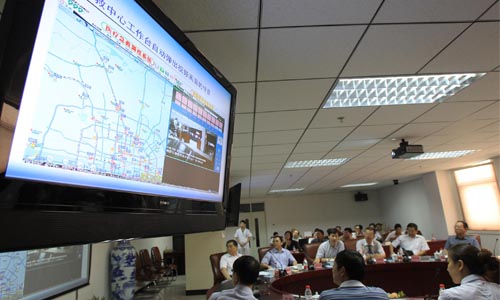|
 |
|
LIGHTENING FAST RESPONSE: The Beijing branch of the Red Cross Society launched an intelligent emergency call system on July 22, 2010, which employs 3G mobile telecom technologies and incorporates many video-enabled functions, at its emergency center (LI MINGFANG) |
The lack of core information technologies will remain a stern challenge, and more than 90 percent of personal computers and basic software are imported, he said. And 90 percent of professional equipment and industrial software are imported to facilitate IT applications in enterprises seeking industrial and information integration. China has developed the world's most advanced supercomputer, but it had to import thousands of microprocessors to do so. China also has to import core computer components—like the computer numerical control (CNC) system—in order to export CNC machine tools.
Across the globe, countries are striving to gain a foothold in future advanced information technologies, and China should not slack off even slightly, otherwise, the digital divide will expand, Zhou warned.
Domestically, the digital divide between regions is obvious. Beijing and Shanghai, for instance, are leading the country in applications of information technologies, coastal provinces such as Guangdong, Zhejiang and Fujian follow next, while Gansu Province in northwest China and Guizhou Province in southwest China seeing the least coverage, said the blue paper based on a comparison of different regions between 2002 and 2008.
Information-based Development in China
World's largest telecom transmission network: China boasted a network of fiber optic cables totaling 8.27 million km in 2009, of which 837,000 km are long-distance cables. The country has formed the world's largest transmission network, and launched many international land or submarine fiber optic cables linking China with Japan, South Korea and other countries in Asia and Europe.
Most telephone subscribers: China topped the world with a total of 1.06 billion phone subscribers in 2009. And 70.4 percent of its population had mobile phones. A total of 103 million users used broadband connection services, while the broadband coverage reached 7.8 percent of its population.
Fast growth of websites and web pages: The number of websites with .cn domains reached 13.46 million in 2009. The number of websites registered in China increased from 265,000 in 2000 to 3.23 million in 2009. The number of web pages grew from 160 million in 2002 to 33.6 billion in 2009, allowing Chinese netizens access to a wider range of online information.
World's largest number of netizens: China's netizens totaled 384 million by the end of 2009, of which broadband access users totaled 346 million. Mobile access users reached 233 million. The Internet coverage rate stood at 28.9 percent nationwide, higher than the world average of 25.6 percent. Internet users have grown much faster since 2006, with an annual increase of about 80 million.
The shrinking rural-urban digital gap: Promoted by the Chinese Government, 98 percent of townships and 89 percent of villages nationwide were connected to the Internet by the end of 2009. And 95 percent of townships were connected through broadband accesses. The number of rural netizens exceeded 100 million, increasing 26.25 percent in 2009, while those using mobile access stood at 72 million, up 79.3 percent. About 350,000 villagers visited agricultural websites daily at the end of 2009, up 17 percent from the beginning of the year. The number of netizens in west China increased 52 percent, much faster than 40.6 percent in central China and 39.3 percent in east China.
(Source: Analysis and Forecast on China's Informatization (2010)) | 